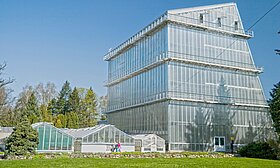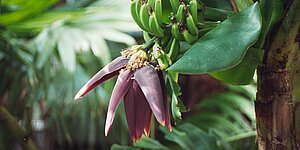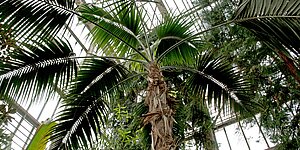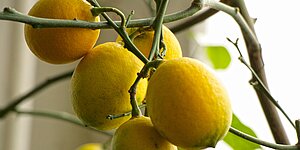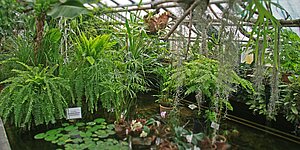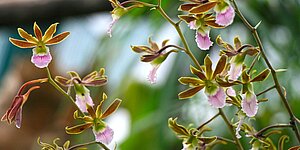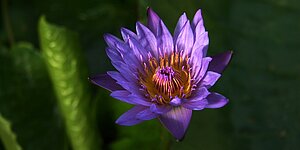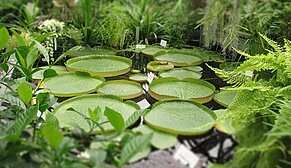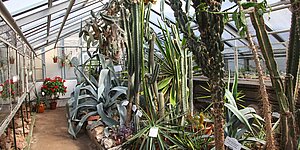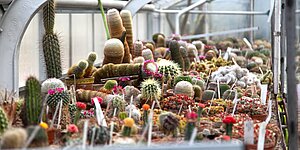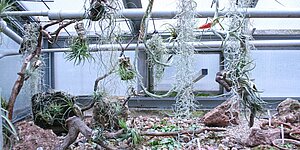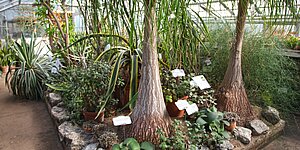Greenhouses are closed due to reconstruction
Collections in the greenhouses demonstrate the diversity of plants from subtropical, tropical, and desert regions. The three greenhouses represent about 1,640 species. More than 30 of these species are endangered and included in the International Union for Conservation of Nature (IUCN), Red List of Threatened Species, or are protected by the Convention on International Trade in Endangered Species of Wild Fauna and Flora (CITES).
The construction of the Botanical Garden greenhouses began in 1928. The first set of buildings included a palm house, a succulent house, and a separate section for orchids and tropical water plants (a tropical house). During the World War II, German army units were deployed at the Botanical Garden and only three gardeners could continue their work. Part of the collection was destroyed. Arboretum trees were used to heat the greenhouses to preserve collections of tropical and subtropical plants. In 1953, the post-war period, the Palm House was enlarged, but in 1972 it was built entirely anew, with a floor space of 550 m2 and 24 m in height.
SUBTROPICAL PLANTS
Exposition is closed for visitors!
Our Palm House hosts subtropical plants with a Mediterranian origin mostly, but there are also species from Australia and Africa. About 400 diferent plants grow here. One of the oldest is Ficus macrophylla from Australia - it grows in the Palm House since 1928. Among 37 different palm species and varieties you will also find the big Araucarias and the relict trees - Metasequoia glyptostroboides and Wollemia nobilis. Some of plants ripe edible fruits, like date tree, lemon thee, laurel, and pomegranate.
TROPICAL PLANTS
Exposition is closed for visitors!
This greenhouse is for plants that prefer warm and humid conditions all year round. For now there are about 400 plant species in our collection, growing in a basin like tropical water lily Victoria cruziana or on the branches of other trees like epiphyte Tillandsia usneoides. The richest is collection of bromeloids from Central and South America, but you will find great variety of begonies, peperomies and philodendrons also.
One of the most characteristic plants of the African tropics is the coffee tree and the African Kigelia or sausage tree. However, the Asian tropical flora is represented by the pointed banana and the Tiger grass - a plant that is widely grown in tropics as an ornamental and creates the effect of bamboo which it resembles.
The orchid lovers will find species from various tropical regions. Among them is vanilla orchid whose climbing trunk has not yet reached the length of 3 meters required for flowering. The lush green jungle atmosphere is provided by more than 50 ferns from different parts of world (genus Adianthum, Nephrolepis, Blechnum).
SUCCULENTS AND CACTI
Exposition is closed for visitors!
Succulent plants grow in deserts and semi-deserts in dry and hot climate with sharp fluctuations of daily air temperature. Plants have adapted to rapid uptake and storage of water by roots, trunk of leaves during the rare periods of rain, as well as from night dew. The exposition of Botanical Garden has about 700 different succulent plants, almost half of them are cacti.
The first part of greenhouse exhibits plants from the North American deserts, especially from Mexico (Agave, Sedum, Echeveria). The oldest specimen is the tuberous opuntia which has been in the collection since 1930.
Plants from the dry regions of Africa are exhibited in the second part of greenhouse. Succulent flora of South Africa and Madagascar is most widely represented with succulent Euphorbia, Crassula, Hawortia, Gasteria, and Aloe.

 CONFERENCE
CONFERENCE